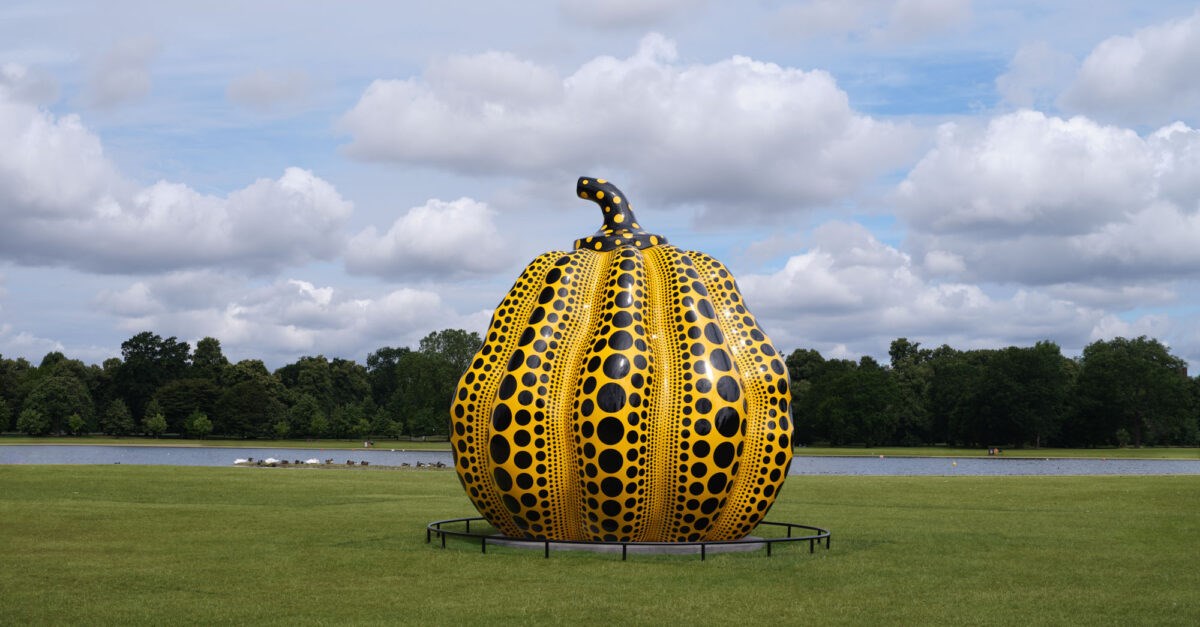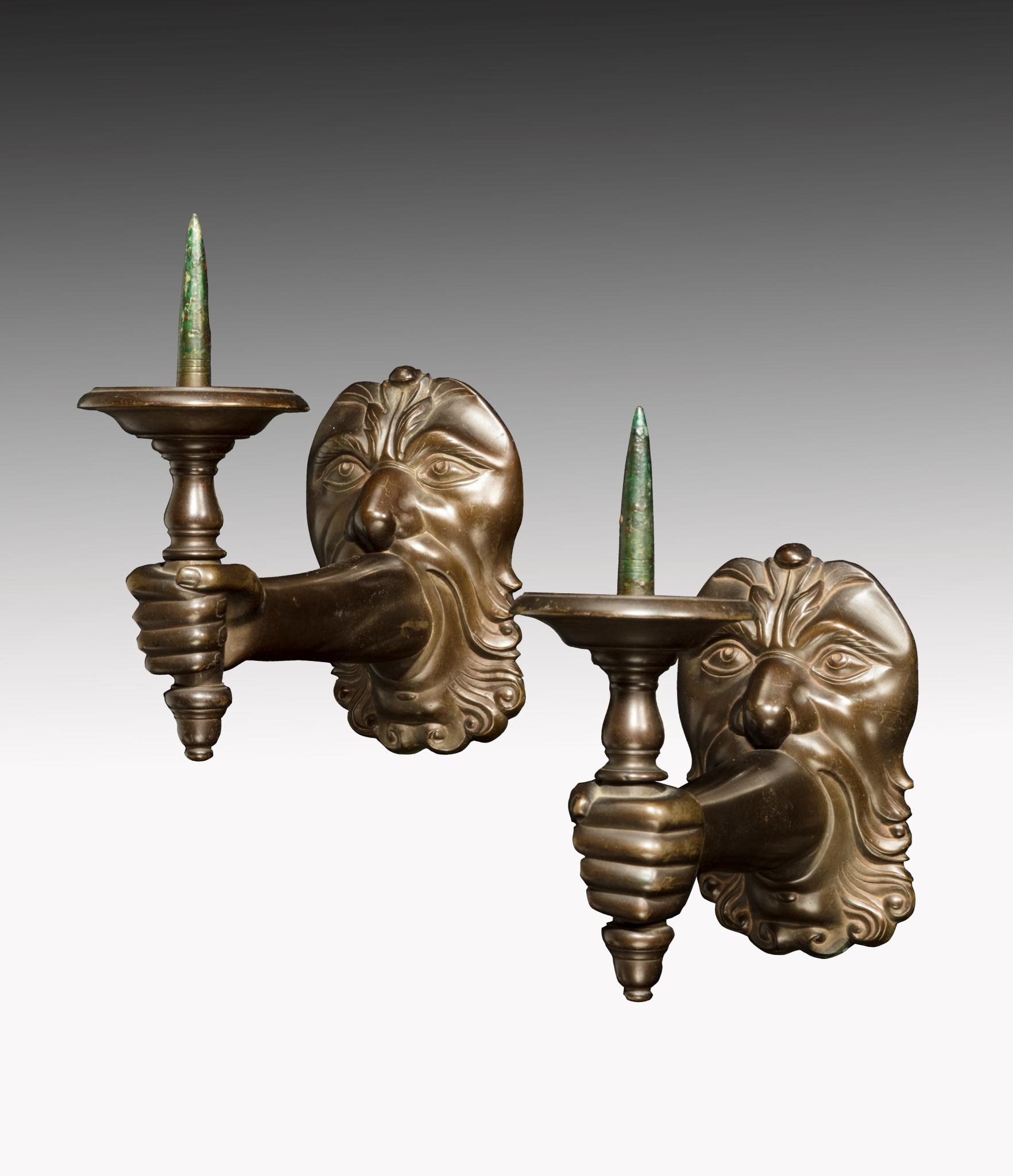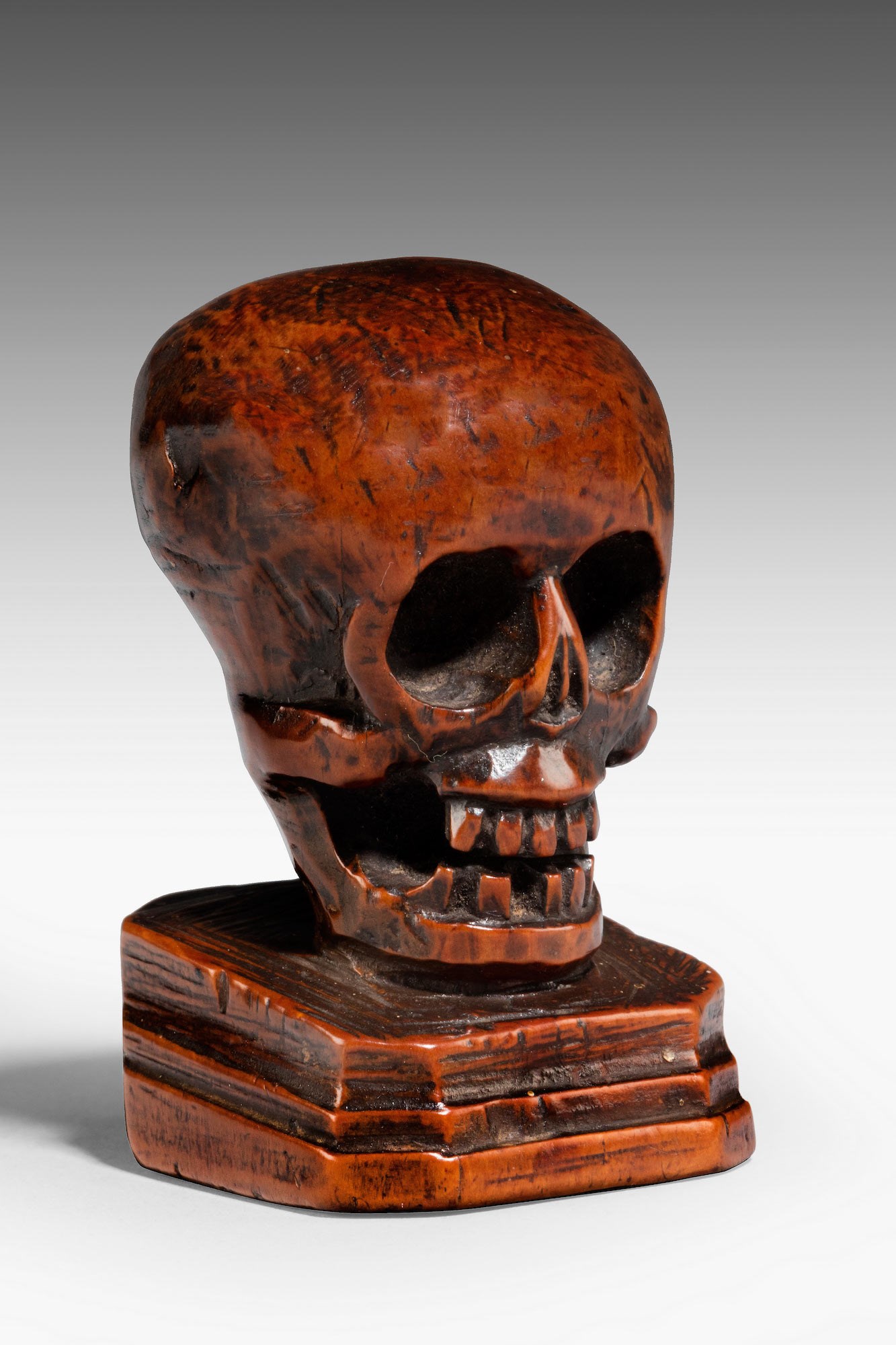Haunting Treasures
30 October 2024
Share
Unveiling Spooky Masterpieces
By Catherine Milner
Catherine Milner is a journalist, curator, Creative Director of Messums and editor of The Treasure House Fair Magazine.
Halloween’s transformation from a modest American celebration into what has become a major cultural event throughout Europe but particularly in the UK, began with the influence of films like E.T and Hocus Pocus, but now dominates supermarket shelves, motorway service stations - even art galleries.
From a six foot pumpkin by Yayoi Kusama currently outside the Serpentine art gallery in Hyde Park to the exhibition celebrating horror film director Tim Burton at the Design Museum, Halloween is celebrated everywhere. Even the London Wetlands Centre is advertising a Supernatural Tour to its visitors - presumably of frogs and toads.

Yayoi Kusama, Pumpkin, 2024
Image courtesy of Serpentine Galleries
Halloween has both Christian and pagan roots; its Christian origins link to the feast of All Hallows’ Eve, which is the evening beforeAll Saints’ Day on November 1. Its pagan roots emanate from the ancient Celtic festival of Samhain celebrated in Ireland, Scotland, and parts of Northern Europe, marking the end of the harvest season and the beginning of winter, and the thinning of the boundary between the living and the dead.
Yet contemporary Halloween celebrations are principally focused on devouring sweets or money from long-suffering neighbours if you are a child, and creating horror-themed costumes and party food after a grim day out in Tescos, if you are a parent.
We once held a far deeper, more dignified approach to contemplating death, paired with far richer artistic expressions; most notably in the Vanitas paintings of the 16th century and the Symbolist works of the late 19th century.
Thomas Coulborn is currently selling a pair of German bronze ‘grotesque’ wall light brackets, designed in the 1600’s featuring a fist emerging from the mouth of a man to spookily hold a candle.

Pair of 17th century German Baroque Bronze Wall Lights
Image courtesy of Thomas Coulborn & Sons
Equally, the company recently held a boxwood snuffbox carved into the shape of a skull that reminded its owner of the damage he was doing to himself every time he took a sniff.

18th Century Flemish Memento Mori Carved Boxwood
Image courtesy of Thomas Coulborn & Sons
Philip Mould is currently selling a momento mori by Cedric Morris which, if not Halloween ish exactly, depicts a purple iris and a dead moorhen to form a visual representation of the transition between life and death.
_T638659003779316006.jpg)
Cedric Morris, Natura Morta ,1947, oil on canvas
Image courtesy of Philip Mould & Company
Wartski is known for exquisite objets and fine jewellery, so Halloween-themed items here include Fabergé-style eggs or small decorative boxes featuring intricate, Gothic motifs like bats, spiderwebs, or ravens in blackened or oxidised metals. Antique jewellery with black diamonds, onyx, or deep red garnets in ornate, antique settings could evoke a subtle Halloween-inspired touch that also reflects current jewellery trends.
Halloween’s grip is not restricted to the West, however. In recent years it has become highly popular in Japan, where it draws upon centuries of haunting imagery.
Laura Bordignon sells netsuke or ojime beads: small, eerie but refined carvings depicting supernatural creatures from Japanese folklore, like kitsune (fox spirits) or oni (demons), that would once have been carved into clothes toggles to ward off evil.
Elegant carvings of tengu (a mythological, birdlike spirit) or yokai (spirit creatures) in bronze or ivory, though not strictly Halloween-related, bring a mysterious and supernatural element to any collection.
The Japanese love of mists and ethereal landscapes populated by twisting trees and wraith-like figures of the sort you see in the pictures and ceramics sold by the House of Kanata convey a haunted, otherworldly atmosphere without being overtly frightening.
The interior designer, Rose Uniacke is known for her minimalist yet rich interiors, so Halloween pieces here might include Gothic-revival candelabras with a matte finish or minimalist skull-shaped sculptures in bone or alabaster that could stand alone as sculptural art.
And a spooky mise-en-scene could be created with the help of Adrian Alan who specialises in opulent Gothic candelabras or chandeliers with dripping wax effects as well as mystical Ormulu clocks.
But for those keen to conjure up a merry Halloween, Kate Malone’s stoneware pumpkins sold by Adrian Sassoon, are a tribute to fertility and fecundity rather than the graveyard.
PhotographybySylvainDeleu_T638658994911532118.jpg)
Kate Malone, Crystal-filled Pumpkin, 2023
Image courtesy of Adrian Sassoon, London. © Photography by Sylvain Deleu.
‘I was encouraged by seeing those brave pumpkins, a symbol also of tenacity and generosity as they bring a harvest to the late time of the year,’ says Malone. ‘It’s extraordinary when you see a field of pumpkins where the leaves have died back and the pumpkins are lying there boldly and brazenly on the earth. You might think the contact with the earth and the weight of the pumpkins would spoil them but their skin is so strong and so compact and practical that they sit there without getting sodden.’
So not in the spirit of Halloween exactly, but perhaps more uplifting and enduring.
By Catherine Milner
Catherine Milner is a journalist, curator, Creative Director of Messums and editor of The Treasure House Fair Magazine.
Halloween’s transformation from a modest American celebration into what has become a major cultural event throughout Europe but particularly in the UK, began with the influence of films like E.T and Hocus Pocus, but now dominates supermarket shelves, motorway service stations - even art galleries.
From a six foot pumpkin by Yayoi Kusama currently outside the Serpentine art gallery in Hyde Park to the exhibition celebrating horror film director Tim Burton at the Design Museum, Halloween is celebrated everywhere. Even the London Wetlands Centre is advertising a Supernatural Tour to its visitors - presumably of frogs and toads.

Yayoi Kusama, Pumpkin, 2024
Image courtesy of Serpentine Galleries
Halloween has both Christian and pagan roots; its Christian origins link to the feast of All Hallows’ Eve, which is the evening beforeAll Saints’ Day on November 1. Its pagan roots emanate from the ancient Celtic festival of Samhain celebrated in Ireland, Scotland, and parts of Northern Europe, marking the end of the harvest season and the beginning of winter, and the thinning of the boundary between the living and the dead.
Yet contemporary Halloween celebrations are principally focused on devouring sweets or money from long-suffering neighbours if you are a child, and creating horror-themed costumes and party food after a grim day out in Tescos, if you are a parent.
We once held a far deeper, more dignified approach to contemplating death, paired with far richer artistic expressions; most notably in the Vanitas paintings of the 16th century and the Symbolist works of the late 19th century.
Thomas Coulborn is currently selling a pair of German bronze ‘grotesque’ wall light brackets, designed in the 1600’s featuring a fist emerging from the mouth of a man to spookily hold a candle.

Pair of 17th century German Baroque Bronze Wall Lights
Image courtesy of Thomas Coulborn & Sons
Equally, the company recently held a boxwood snuffbox carved into the shape of a skull that reminded its owner of the damage he was doing to himself every time he took a sniff.

18th Century Flemish Memento Mori Carved Boxwood
Image courtesy of Thomas Coulborn & Sons
Philip Mould is currently selling a momento mori by Cedric Morris which, if not Halloween ish exactly, depicts a purple iris and a dead moorhen to form a visual representation of the transition between life and death.
_T638659003779316006.jpg)
Cedric Morris, Natura Morta ,1947, oil on canvas
Image courtesy of Philip Mould & Company
Wartski is known for exquisite objets and fine jewellery, so Halloween-themed items here include Fabergé-style eggs or small decorative boxes featuring intricate, Gothic motifs like bats, spiderwebs, or ravens in blackened or oxidised metals. Antique jewellery with black diamonds, onyx, or deep red garnets in ornate, antique settings could evoke a subtle Halloween-inspired touch that also reflects current jewellery trends.
Halloween’s grip is not restricted to the West, however. In recent years it has become highly popular in Japan, where it draws upon centuries of haunting imagery.
Laura Bordignon sells netsuke or ojime beads: small, eerie but refined carvings depicting supernatural creatures from Japanese folklore, like kitsune (fox spirits) or oni (demons), that would once have been carved into clothes toggles to ward off evil.
Elegant carvings of tengu (a mythological, birdlike spirit) or yokai (spirit creatures) in bronze or ivory, though not strictly Halloween-related, bring a mysterious and supernatural element to any collection.
The Japanese love of mists and ethereal landscapes populated by twisting trees and wraith-like figures of the sort you see in the pictures and ceramics sold by the House of Kanata convey a haunted, otherworldly atmosphere without being overtly frightening.
The interior designer, Rose Uniacke is known for her minimalist yet rich interiors, so Halloween pieces here might include Gothic-revival candelabras with a matte finish or minimalist skull-shaped sculptures in bone or alabaster that could stand alone as sculptural art.
And a spooky mise-en-scene could be created with the help of Adrian Alan who specialises in opulent Gothic candelabras or chandeliers with dripping wax effects as well as mystical Ormulu clocks.
But for those keen to conjure up a merry Halloween, Kate Malone’s stoneware pumpkins sold by Adrian Sassoon, are a tribute to fertility and fecundity rather than the graveyard.
PhotographybySylvainDeleu_T638658994911532118.jpg)
Kate Malone, Crystal-filled Pumpkin, 2023
Image courtesy of Adrian Sassoon, London. © Photography by Sylvain Deleu.
‘I was encouraged by seeing those brave pumpkins, a symbol also of tenacity and generosity as they bring a harvest to the late time of the year,’ says Malone. ‘It’s extraordinary when you see a field of pumpkins where the leaves have died back and the pumpkins are lying there boldly and brazenly on the earth. You might think the contact with the earth and the weight of the pumpkins would spoil them but their skin is so strong and so compact and practical that they sit there without getting sodden.’
So not in the spirit of Halloween exactly, but perhaps more uplifting and enduring.

